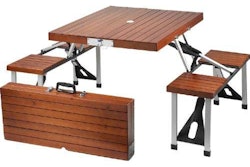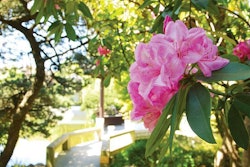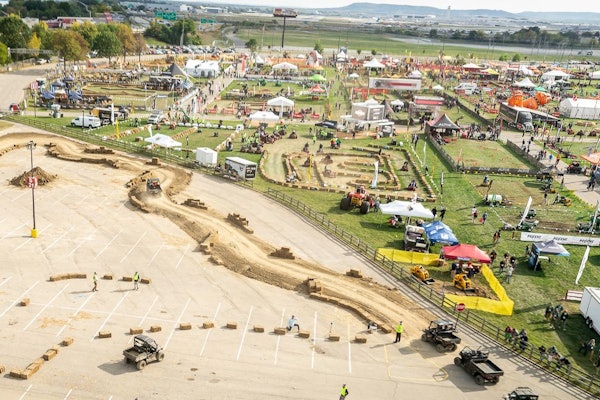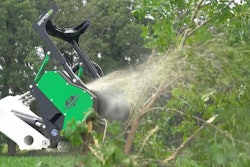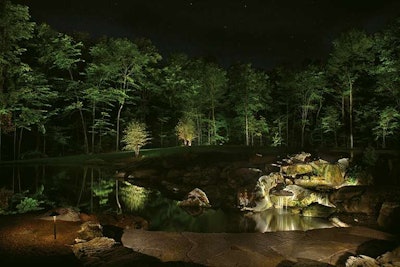 Photo: Michael Epaul
Photo: Michael EpaulWhether it’s a three-tiered fountain, a rambling stream or a spectacular waterfall, lighting shows off water’s magical qualities after dark. But you can’t just install a spotlight and call it a day.
“Lighting water features is the most complicated kind of lighting,” says Janet Lennox Moyer, IALD, COLD, author of “The Landscape Lighting Book” and founder of the nonprofit Landscape Lighting Resource in Troy, New York. “You must take into account a number of issues such as the clarity of the water, the type of materials you’re lighting and where you’re going to hide cables and junction boxes. It takes a lot of thought and planning.”
Here’s what to keep in mind when using low-voltage lighting for your water feature projects:
1. Create a mood
Proper lighting transforms a water feature. “Lighting should enhance the feeling of serenity,” says Phillip W. Costello Jr., COLD, owner of Illumascape Landscape Lighting in South Hadley, Massachusetts. “You get much more out of a water feature by being able to enjoy it at night, too.”
For example, when there’s water in front of a feature, such as a waterfall with a pond in front of it, position the light so it skims across the surface of the water. This creates a peaceful, mirrored surface when the water is calm and a glimmering effect when it’s moving.
To continue this relaxing mood with the feature, make sure people notice your vision, not the wires. When possible, get involved during the construction phase of a water feature so you can properly light the project and more easily camouflage fixtures.
But if you’re called in after the fact, assume you’ll have to dig, disassemble and reassemble some aspects of the water feature to hide parts such as transformers and wires.
It’s also not necessary to submerse lights to achieve interesting effects. “Think about lighting a waterfall from behind or using a wash light,” says Andrew Coleman, outdoor lighting designer with McKay Landscape Lighting in Omaha, Nebraska. “If you stay out of the water, it’s far less expensive and less maintenance in the long run.”
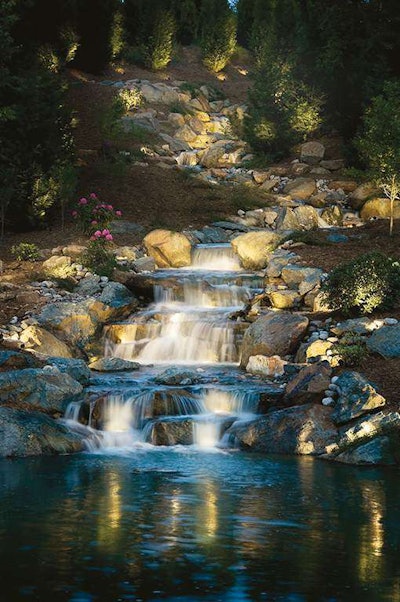 Kichler Lighting’s pond, floating and underwater 12-volt water lights bring features to life at night.
Kichler Lighting’s pond, floating and underwater 12-volt water lights bring features to life at night.2. Use adequate light
Not using enough light is one of the most common mistakes when lighting water features. “Water dissipates light,” says Paul Gosselin, president of NightScenes in Austin, Texas. “If you’re submersing lights, you’ve got to add a lot more light than you think you need.”
While there’s no specific formula to follow, figure on at least 1/3 to 1/2 more than you anticipated, Gosselin advises. You may have to boost it even more depending on the depth, clarity of the water and the material you’re lighting. For example, dark stone absorbs light, while light-colored stonework reflects it.
3. Experiment with design
Another way to get the desired result with the light is to play around with the fixtures, Moyer says. “You can’t predict what water will do with light.”
She suggests testing the effects of fixtures in a bathtub, using a hose to watch how the light looks with the fall or spray of water. Or, create a mock-up on the jobsite. Experimenting lets you see how everything pulls together.
For example, “when lighting a waterfall to highlight movement, aim the light where the falling water hits the horizontal surface so the light catches the air bubbles,” Moyer says. “Aiming at the edge where the water goes over doesn’t create the same effect.
When submersing lights, you may not necessarily get light where you think you will. “You know how you’d aim light at a statue or a structure, but water bends light,” Gosselin says. “You’ve got to get in there and adjust placement. It’s a skill that comes with practice and experience.”
While you’re at it, be careful of glare. You don’t want to shoot light toward the feature, only to discover you’re blasting a bedroom window or creating a hazard on a walkway because the homeowner is blinded as he comes out the door to the patio.
To save yourself time and a lot of frustration, avoid doing permanent installs of fixtures until you’ve made nighttime adjustments. “The final adjustment is crucial,” Gosselin says. “You’d be surprised how many inexperienced designers don’t go back after dark and fine-tune their work.”
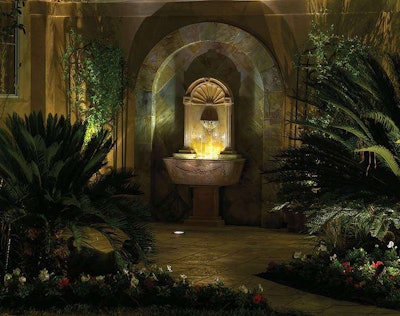 Winning the 2011 Association of Outdoor Lighting Professionals (AOLP) annual outdoor lighting design competition, this project blends architectural and landscape lighting with this water feature.
Winning the 2011 Association of Outdoor Lighting Professionals (AOLP) annual outdoor lighting design competition, this project blends architectural and landscape lighting with this water feature. Photo: Starshine of Texas
4. Accommodate pond life
Keep the environment healthy for fish by providing an area within ponds where it remains dark and quiet, Moyer advises. It can be a cave, a corner or even the stones under a walkway.
Be aware that in small ponds, lighting can change water temperature, which can be detrimental because fish can’t endure large temperature variations day after day. Also, avoid submersible fixtures made of copper or zinc, which can be toxic to fish. Stainless steel or polycarbonate materials are better choices.
5. Maintain systems
Educate your clients about lighting and explain it requires ongoing care: Plants grow and cover lights. Mulch gets piled up in front of fixtures. Lenses get cloudy from calcium buildup. Cords get cut by animals or mowers.
“Avoid selling products or lighting systems as ‘no maintenance,’” says Bernie Granier, principal with Starshine of Texas in the Greater Houston area. “Typically, you need to get out there at least every three to six months to clean, re-aim and re-position your lights.”
Consider offering a service contract that includes cleanings and adjustments on a regular basis such as at the start of the season and mid-season. In some markets where water features run year-round, more frequent maintenance calls may be necessary.
6. Get comfortable with lights
Many contractors and lighting designers have transitioned completely to the use of LEDs for landscape lighting. While LEDs cost at least twice as much as traditional fixtures, they cost less in the long run as they have less amperage pull, less energy use and a longer lamp life, Gosselin says.
In recent years, the color temperature has improved, as well, offering a mellow glow instead of the harsh, bluish tint that many people didn’t like when LEDs first entered the marketplace. Because the market is changing rapidly with many companies coming and going, stick with reputable suppliers and well-known manufacturers that offer warranties (many promise 40,000 hours or more).
You also need to be familiar with any lighting laws in your area. Check with your municipality or local building department about permit and licensing requirements. While many states have no or few requirements when it comes to lighting water features, other states, such as New Jersey, allow only licensed electrical contractors to install low-voltage lighting.
Some communities also have Dark Sky regulations concerning the excessive use of lighting in the outdoor environment.
It’s also important to know that low-voltage lighting cannot be used in pools and spas; you’ll need a licensed electrical contractor and grounded line for lighting these features.

